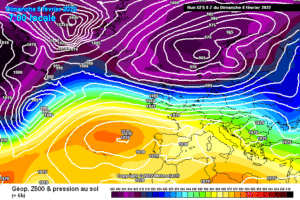Feburary Far From Quiet
As the corridors of No. 10 rock from storm to storm, instead of tackling the economy, living standards or energy, so too the weather sees us like corks on a rough sea, as the normally quieter Northern Jet stream ramps up, to deliver a month long conveyor belt of changeable weather, from mild sector respites to Showery polar maritime plunges, the see-saw continues. The frontal boundaries will keep the February fill-dyke nickname in mind, but unless you are hill climbing – the type of precipitation will be black (rain) and Not white (snow), as the old weather lore saying continued.
If we have an energy crisis here – then there certainly wont be with the Atlantic jet stream, which fuelled by a very cold polar vortex over N. Canada, will send furious shafts of 200 mph winds from west to east across “The Pond” to fuel the Troposphere winds that in turn will turn the wind mills that would, If increased in terms of investment, as the Octopus energy CEO pleaded, be a game changer for energy prices here in the UK. This is not true of nuclear – which leaves a waste legacy costing for thousands of years ahead to manage the containment and air conditioning needed to keep it cool, using more power. The irony is that wind and tidal power generation is cheaper, and leaves no legacy to repay.
There really is no sign right now of the Atlantic conveyor slowing down, so perhaps march will see a winter plunge. By then at least the daff’s will be blooming and the sun beginning to feel warm. Already the cheery faces of snowdrops grace our gardens and the bossy and brazen little aconites are bravely shouting for spring.
The synoptic context of this winter defied us forecasters this year, being a year that boasted the unusual combination of La Niña ENSO cycle, that can mean a more amplified jet – especially in December (though the cold spell then was very short and flattered to deceive), the Maunder Minimum, being the low point in the decadal sun-spot cycle, which favours cold winters and the easterly quasi-biennial oscillation favours more blocking high pressures. We did get a block in January, of course, but not in the cold weather delivering usual place (Scandinavia), but instead a displaced, balmy Azores high.
It is perhaps not so surprising to see the Jet so strong as the energy in the weather systems is so much greater than in the decades that surrounded my childhood, and in that vein, in the last 10 years, just 3 winter months (Dec, Jan & Feb), have had average temperature readings below the 1960-1990 average. I.e. 3 out of 30. 27 out of 30 were above that average.
The energy crisis needs to be the catalyst for investing in self sufficiency in energy – the future should then be bright – the future should be electric!
#economy
#future
#energy
#investment
#power
#maritime
Here’s the charts showing the see-saw Atlantic conveyor belt in ramp mode…





